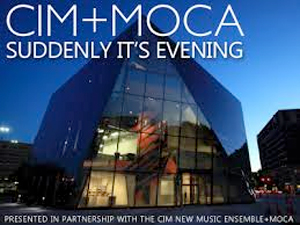by Timothy Robson

(A rhetorical question: Can one describe as “new” such works as George Crumb’s Madrigals, composed almost fifty years ago? Only the closing work on the program, Harrison Birtwistle’s 2007 Cortege, was composed in the last ten years, with Donald Erb’s Suddenly It’s Evening dating from 1997.)
The program was broken into three distinct segments, each in a different location in MOCA. The sections were separated by time allowing the audience not only to move to the next location, but also to examine the exhibition’s objects in the galleries.
The opening works were George Crumb’s Madrigals, Books II and III (1965 and 1969, respectively) for solo soprano (Kristin Hogan), flutes (Jeiran Hasan), harp (Xiao Du) and percussion (Lara Hueter). In each book, Crumb sets fragments of mostly morbid poems in Spanish by Federico García-Lorca.
Crumb (b. 1929) is noted for his keen ear for instrumental and vocal sonority, calling for a variety of vocal techniques, from high coloratura to low contralto range, to whispers and “sung-speech.” The instrumentalists engage in elaborate technical challenges as well. Crumb calls upon the percussionist to hum and murmur while playing the battery of instruments, as well as sounding the strings of the harp with mallets. The flutist plays standard flute, alto flute and piccolo, allowing a range of sounds from low, sensuous melodies to piercing shrieks.
Kristin Hogan was fearless in her assumption of the jagged vocal lines, although her singing of the Spanish texts was not especially idiomatic. The instrumentalists had a good sense of the delicate sonorities and balances required for the work’s effective presentation.
After a fifteen minute break, the audience reassembled in the main room of MOCA’s fourth floor gallery for Donald Erb’s Suddenly It’s Evening for solo cello, here brilliantly played by Pall Quinn Kalmansson. The title is extracted from a three-line poem by Salvatore Quasimodo:
Each of us is alone on the heart of the earth
Pierced by a ray of sun
And suddenly it’s evening.
The work is in four movements, alternating slow and fast. In each, the performer is not only required to play the cello, but also to hum, and sometimes sing vowel sounds that are related to the overtones of the bowed instrument.
The first, “Xanax in Xanadu” is a lament, with long, low drone-ish passages interrupted by pizzicati. Here, as later in the piece, the cellist hums along, almost as if he is the composer improvising, and singing the tunes while he creates the music. The later movements had strong emotional impact, both melancholy and lyric as well as virtuosic and fierce.
Kalmansson’s fine performance was especially in tune with two of the art works displayed in the gallery. Irish artist Cecily Brennan’s “Black Tears” (2010), a video loop of a pale middle-aged woman crying, is almost unbearably sad. Hannah Wilke’s large posthumous video installation “Intra-Venus Tapes 1990-1993” is a wall of sixteen identical video monitors simultaneously playing random scenes from the artist’s own treatment and decline to death in 1993 from lymphoma. Wilke’s work is not for the faint of heart but matched the subject of the evening’s concert.
After another break, the concert concluded on the street level space with genius-modernist Harrison Birtwistle’s Cortege (2007) for wind and string instruments, plus bass drum and piano. Birtwistle’s works are infused both with theatricality and musical complexity in the guise of many alluring musical sounds. He is an experienced opera composer, but with Cortege he integrates concert music with ritual.
The performers are arranged in semicircle, and during the performance each of the instrumentalists (except the bass drum and piano) walks to a central spot in the center of the ensemble for a “featured” solo, before returning to a seated position on the opposite side of the semicircle and becoming again a part of the ensemble. The CIM performers captured the inexorable progress of the somber, yet ecstatically filigreed music.
The concept of presenting a themed concert in the galleries was a good one that should be continued; however, some of the logistics left something to be desired. The Crumb works, with their array of percussion spread out through a relatively small gallery, did not leave enough comfortable space for the substantial audience, yet the second work for solo instrument was performed in the main gallery space. One of the gallery guards left her walkie-talkie on through the performance, which injected unexpected spoken commentary into Crumb’s subtle effects.
There were no apparent arrangements for elderly or disabled audience members to sit for the first two works; the staff had to scramble to find chairs and stools for some of those present. Only the Birtwistle was presented in a more standard concert arrangement. After an hour standing, the plastic straight-back chair was welcome.
Published on ClevelandClassical.com March 24, 2014
Click here for a printable version of this article.


